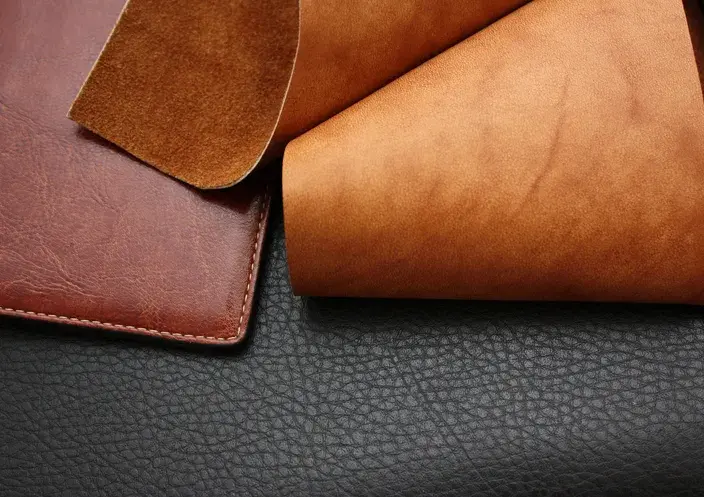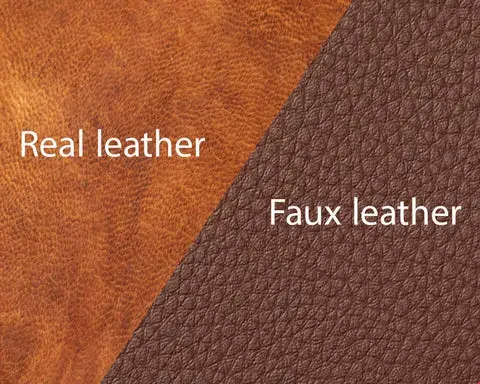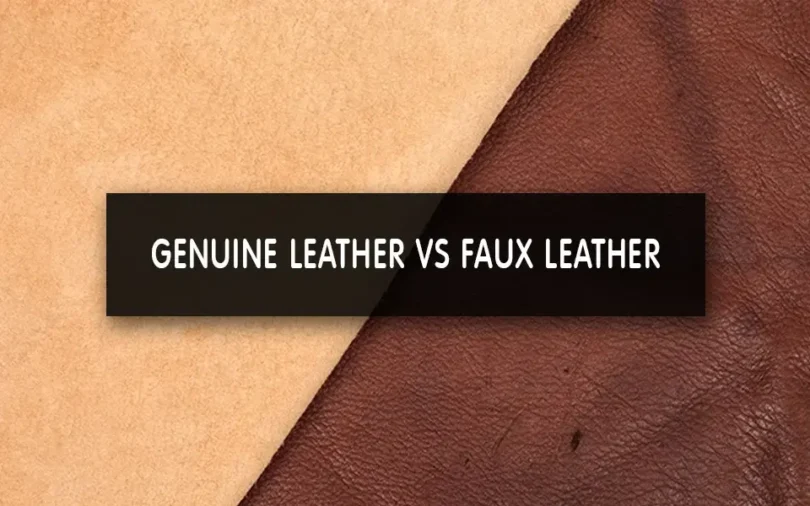Leather has been popular for a long time, but not all Leather is the same. There are two main types: Genuine Leather and Faux Leather. Genuine Leather comes from animals, is strong, and feels natural. It can cost more, but it’s worth it because it lasts long. Faux Leather, on the other hand, is not made from animals. It looks and feels like genuine Leather, but it’s usually cheaper and might only last for a while or feel authentic. So, when buying Leather, consider what’s more important to you: quality and durability or cost and imitation.
Introduction to Genuine Leather:

Genuine Leather is a material that people have used for a long time. People like it because it is strong, lasts long, and looks natural and pleasant. It comes from the skin of animals like cows, sheep, and goats. They treat the skin to make it rugged and bendy so they can make different things out of it. One specific thing about genuine Leather is its unique texture and pattern. It comes from the kind of animal and the way they treat the skin. Each piece of Leather is, therefore, distinctive and unique. Because of this, it is for high-end fashion items such as coats, purses, and shoes.
Introduction to Faux Leather:
Faux Leather, also called fake or vegan Leather, is an artificial material that tries to copy the look and feel of genuine Leather. Typically, people make it by covering a fabric or foam with a special coating called polyurethane (PU) or polyvinyl chloride (PVC). Even though it’s not as fancy as genuine Leather, faux Leather has become more popular lately because it’s cheaper, can be used for many things, and doesn’t harm animals. One cool thing about faux Leather is that it is highly customizable. They create it in a lab so the manufacturers can make it look and feel differently for various uses. For example, it can look like fancy animal skins like crocodiles or snakes, or they can put fancy patterns on it. And you can find it in many colors, from standard black and brown to bright and eye-catching ones.
Differences between Genuine Leather and Faux Leather:

Genuine leather comes from animal skin, is very strong, and lasts long. People have used it for a long time to make clothes, things to wear, and furniture. But there’s also something called faux leather, which makes it look and feel like genuine leather but not made from animals. It’s usually cheaper than genuine leather, but it only lasts briefly. The most significant difference between real and faux leather is how they affect the environment. Genuine leather comes from animals used for their meat, so it doesn’t need extra resources. But faux leather is often made from oil, which can harm the environment when turned into Faux Leather. Also, faux leather doesn’t break down rapidly, so it can stay in the background for hundreds of years.
Look, Feel, and Smell of Genuine Leather and Faux Leather:
Genuine leather has a distinctive look, feel, and smell that distinguishes it from faux leather. Natural markings, such as scars and wrinkles, characterize its appearance, giving it a unique and authentic appeal. The texture of genuine leather is soft and supple, with a rich and luxurious feel that improves with age. Its scent is earthy and musky, evoking images of the great outdoors and adventure.
Faux leather, on the other hand, lacks the natural markings and texture of genuine leather, giving it a smooth and uniform appearance. The texture is often stiffer and less pliable than Genuine leather, and it may have a slightly plastic-like feel. Some faux leathers mimic the scent of genuine leather, and they often need to catch up in capturing the complex and nuanced aroma of the real thing.
Cleaning and Maintenance of Genuine Leather and Faux Leather:

Taking care of genuine leather is vital to make it look nice. First, use a dry cloth to remove dust or dirt from the leather. Next, put a little leather cleaner on a soft cloth and rub it gently on the leather in circles. After that, use a conditioner to keep the leather subtle and prevent it from cracking. Don’t use water or strong chemicals on genuine leather because they can harm it. Faux leather is more serene to care for than Genuine leather but still needs attention to look good. Start by wiping it with a dry cloth to get rid of dust. Then, make a mild soap and warm water mixture and use a soft cloth to clean the faux leather. Rinse the cloth in clean water and wipe away any soap on the surface. Finally, use a dry cloth to pat the Faux leather dry and remove extra moisture. Avoid using rough stuff or strong chemicals on faux leather because they can make it crack or peel.
The difference in Pricing of Genuine Leather and Faux Leather:
Genuine and faux leather differ in price because of where they come from and the way manufacturers produce them.
Animal skins like cowhide or sheepskin constitute the raw material for genuine leather. It’s natural, and the cost depends on the quality and kind of leather used. Full-grain leather, which keeps the original marks on the skin, is usually more expensive. Real leather stuff can be pricier because it takes a lot of work to make.
Faux leather, synthetic or artificial leather, is made from things like polyurethane (PU) or polyvinyl chloride (PVC). It typically costs less than genuine leather due to its production with cheaper materials in large quantities. Faux leather can look like Genuine leather but doesn’t last as long and isn’t as rugged.
Which Leather Is Right For You? Genuine or Faux:
Deciding between genuine and faux leather depends on what you like, what you need, and how much you can afford:
Genuine Leather is Good If:
You want something that lasts a long time. Genuine leather usually stays in good shape if you take care of it. You like how Genuine leather feels and looks as it gets older. You are okay with spending more money upfront for something that will be a good investment in the long run.
Faux Leather is Good If:
You only have a little money to spend and want something cheaper. You prefer products that don’t harm animals. If You want something that looks like leather for fashion but doesn’t need to be as challenging as genuine leather.
Conclusion:
In summary, genuine and faux leather differ regarding cost and how well they work for various purposes.
People like genuine leather because it’s tough and looks natural but costs more money. Faux leather is cheaper and doesn’t involve animals, but it might only last for a while. So, which one you choose depends on what’s important to you, how much money you have, and what you plan to use it for.
Is faux leather environmentally friendly?
Faux leather can be kinder to animals, but it might not always be friendly to our planet. Manufacturers create faux leather from manufactured plastics, which can harm the environment. If you want eco-friendly faux leather, look for ones made from sustainable or recycled materials.
How can I differentiate between genuine and faux leather?
Genuine leather often has natural flaws and differences in texture, while faux leather looks more consistent and even. You can also check for labels, smell (genuine leather has a unique scent), and feel the material to determine whether it’s real or faux.
Can faux leather be as durable as genuine leather?
Usually, genuine leather is more rugged than faux leather. Even though it can copy the appearance of leather, it might not hold up as well to wear and tear over time. Good-quality faux leather can still last a while, but it might not stay in good shape as long as genuine leather.
What is bonded leather?
Bonded leather is made by sticking together bits and fibers of genuine leather with glue. It’s often cheaper than top-quality leather, but it could be better quality and how long it lasts.







